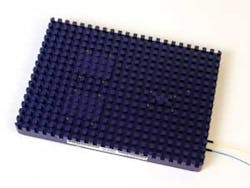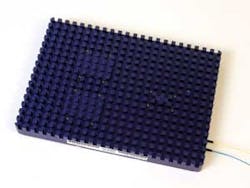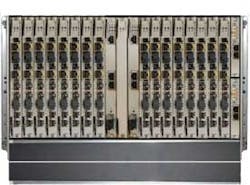Cisco’s planned acquisition of CoreOptics, supplier of extended-reach, high-speed electronics and modules, should give the company a direct line toward 100-Gbps capabilities. Analysts debated as this issue went to press whether the deal signaled a move into the packet optical transport space. But another point of debate also is worth pondering: Do Nokia Siemens Networks and Fujitsu Network Communications (and, some speculate, Ericsson) want Cisco to supply them with 40-Gbps coherent modules?
Several 40G module vendors no doubt hope that CoreOptics’ customers will seek new suppliers.
Cisco says it will continue to support CoreOptics’ current 10G and 40G customers after the transaction closes later this year. But it seems unlikely that all CoreOptics’ current clients, particularly at 40G, will want to rely on a competitor for high-speed module supply.
So who hears opportunity knocking? Mintera and JDSU both have 40G coherent modules on their near-term roadmaps. (You can see Terry Minter, president and CEO at Mintera, discuss his company’s coherent strategy on the Lightwave Channel.) Both companies have targeted the end of this year for first shipments.
Meanwhile, Opnext has focused its initial coherent developments on 100 Gbps. A 40G product is slated to appear ”shortly after” the 100G capabilties appear at the end of this year, company sources told Lightwave at OFC/NFOEC in San Diego this past March. One wonders if the fire to get that 40G offering out the door may get turned up. – StepHen Hardy
Who needs 40G?
Of course, Opnext may be perfectly comfortable with its current timetable if it sees more opportunity at 100 Gbps than it does at 40 Gbps. Certainly that’s the case at Infinera, which released its coherent-enabled 40G/100G roadmap in May.
Infinera CTO Drew Perkins told Lightwave that the rapid advent of commercially viable 100G platforms would significantly limit the demand for 40G systems. Infinera will still provide both, but the company doesn’t expect a lot from the lower-speed offering.
The difference in expectations can be seen in how much in-house horsepower the company put behind the development of the two capabilities. Infinera touted the benefits of its photonic integrated circuit (PIC) approach for 100G applications. However, the coherent 40G capabilities won’t leverage the PICs. Instead, Perkins says Infinera will use a module co-developed with an outside vendor.
Infinera plans to have coherent 40G capabilities ready by 2011, only a year before it expects to deliver coherent 100G. The company will make the 40G technology available on its submarine line terminal equipment, as well as terrestrial systems. – SH
UK to see more FTTH roll outs
BT has found some extra money and plans to use it to deploy more fiber to the home (FTTH) networks. Meanwhile, upstart Fibrecity Holdings has FTTH plans of its own. As is the case throughout Europe, these infrastructures will provide open access to competitors. With the U.S. Federal Communications Commission (FCC) formulating a strategy to execute its National Broadband Plan, might the U.S. take some lessons from these implementations?
While issuing the carrier’s full-year results, Ian Livingston, chief executive of BT, described a three-year plan for the company that includes investments in areas such as fiber broadband, television, and services for global companies and governments in the Asia Pacific region. Livingston’s plan calls for a major expansion of BT’s fiber investment program.
With what BT would consider “an acceptable environment for investment,” Livingston said BT’s broadband program could potentially be extended to make FTTH available to around two-thirds of UK homes by 2015. The investment for this roll out, approximately £2.5 billion, will be managed within BT’s current capex levels, he asserted.
The carrier believes the £2.5 billion earmarked for fiber is one of the largest in the world that doesn’t rely on public sector funding and where the network is open to all service providers on an equal basis.
Meanwhile, Fibrecity Holdings, an i3 Group company, has announced new Fibrecity networks. The expansion will result in more than 1 million homes and businesses being connected over the next four years. The networks will deliver standard speeds of 100 Mbps and boosts of up to 1 Gbps through what Fibrecity touts as the largest FTTH initiative in the UK.
As noted, such open-access strategies have found favor with regulators across Europe. In the U.S., the government has begun to encourage similar approaches. Proposals based on open access models were rewarded several times within Phase 1 of the broadband stimulus program, for example. So far, however, what we’ve heard about the National Broadband Plan, which has “design policies for robust competition” as one of its stated goals, does not include open access as a tool to implement such objectives. However, with the FCC looking to reclassify broadband services as a way of implementing the National Broadband Plan, many carriers and observers are concerned that line sharing may become part of the FCC’s strategy.
The success of a straightforward approach to optical line sharing might sway the FCC more strongly in an open-access direction. This undoubtedly is one of Google’s goals for its open access testbed. – SH
Ericsson offers packet transport strategy
Ericsson is heading in the direction we mentioned Cisco might be: Expanding its packet optical transport system portfolio. In a recent interview with Lightwave, Matthew Smith, head of optical product marketing at Ericsson, indicated an important part of the company’s strategy involves cost-optimization through distributed switching and making optional some features competitors offer as standard.
Like all integrated packet optical transport platforms, Ericsson’s offerings have an integrated WDM capability. However, “one of the things we say with some of the WDM functionality—for example, multi-degree ROADM or OTN switching—is that it should be there as an option,” Smith explained. “Some of the current architectures in this market have been slightly overburdened in that they’ve included that kind of functionality Day One. We like to see it as kind of a pluggable option that people use as and when needed.”
Ericsson’s upcoming OMS 1460 packet optical transport platform will offer 4X the capacity of the current OMS 1410.
Meanwhile, Smith said Ericsson will offer TDM and packet switching in a distributed fashion, which enables customers to better scale the platform to changing requirements, both in terms of adding packet and lambda switching and removing TDM capacity as the network’s traffic mix continues to evolve. This approach also lowers power consumption, he said.
The distributed switching aspect differs distinctly from many other packet optical transport platforms that have an integrated switching capability. As our cover story points out, some would suggest this approach might add latency to network connections.
In addition, the company clearly isn’t pursuing the same level of standalone functionality for each element of its system that Ciena and Cyan are. Those companies assert each element of their systems could stand on their own as individual platforms. Smith says the company’s existing line of MSPPs and add/drop multiplexers would be better suited to applications that don’t require a fully intergrated, packet-friendly platform. – SH
When is a fiber network not a fiber network?
For advertising purposes, when it’s a hybrid fiber/coax (HFC) network, according to the Better Business Bureau Council’s National Advertising Division (NAD). The NAD upheld complaints Verizon lodged against Time Warner Cable and Cox Communications for commercials in which the MSOs described the HFC infrastructure they use to deliver residential services as “fiber networks.”
Time Warner Cable, at least, isn’t willing to roll over. The company plans to appeal the division’s ruling to the National Advertising Review Board.
“Despite the undisputed fact that TWC’s network is more than 90% fiber optic, NAD’s decision seeks to stop TWC from making the true statement that it has a fiber-optic network,” the company said, apparently believing that more than 90% is close enough to 100% not to be worth quibbling about.
Cox, while stating that it still believes it is correct to tell consumers that it operates a fiber-optic network, has agreed to take the NAD’s recommendations into consideration.
Comcast, meanwhile, refused last November to participate in the NAD’s adjudication process of its similar claims. The NAD referred the issue to the Federal Trade Commission.
All of which illustrates that the benefits of fiber technology must be resonating strongly with consumers—whether you’re bringing it to the side of their home or not. You can look for cable MSOs to continue to find ways to point to the fiber in their networks as they compete with Verizon for the hearts, minds, and wallets of residential users. – Sh
PBB-TE: I’m not dead yet
If Provider Backbone Bridging – Traffic Engineering (PBB-TE) is dying at the hands of MPLS-TP, the news hasn’t reached South Africa yet.
Ciena Corp. says that South African wireless broadband service provider iBurst has deployed the systems vendor’s Carrier Ethernet Service Delivery (CESD) platforms to support wireless backhaul for 3G and 4G wireless networks. The network will leverage PBB-TE. In fact, the use of PBB-TE was a major factor in the carrier’s buying decision, the systems provider indicates.
However, most analysts agree that this implementation will likely be the exception that proves the rule. A Heavy Reading report asserts that carriers’ interest in PBB-TE is “significantly less” than it was 18 months ago. Infonetics Research conducted its own study in 2008 that reached the same conclusion. Ciena may have inherited PBB-TE from Nortel, but likely won’t bet the farm on it. – SH


